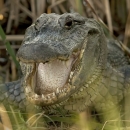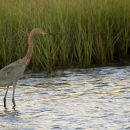About Us
Established in 1966 to provide wintering habitat for migratory waterfowl and other migratory bird species, the refuge provides more than 45,000 acres of salt marsh salt marsh
Salt marshes are found in tidal areas near the coast, where freshwater mixes with saltwater.
Learn more about salt marsh and freshwater sloughs, impoundments and potholes among native coastal prairie uplands. Bastrop Bayou, Big Slough, Oyster Creek and Chocolate Bayou carry freshwater to the bays creating a mosaic of salt marsh, open water mudflats that are shaped by tidal inundation, changing salinity, sediment movements and desiccating winds. This harsh environment is the breeding grounds for fish and shellfish, which support large populations of shore, wading and waterbirds. Texas Mid-coast National Wildlife Refuge Complex is made up of Brazoria, San Bernard and Big Boggy National Wildlife Refuges. They were designated as Internationally Significant Shorebird Sites by the Western Hemisphere Shorebird Reserve Network.
On higher elevations, the saline marsh gives way to saline prairie where seasonal inundation with tidal waters requires salt-tolerant vegetation like gulf cordgrass and sea ox-eye daisy.
Coastal prairie dominates the non-saline soils providing habitat for mammals, reptiles as well as resident and migratory birds. Although much of the upland habitat had been utilized for rice farming and grazing prior to being added to the refuge, the natural ridge-swale topography can be found across Brazoria’s prairie. The swales create freshwater wetlands which add diversity and seasonal wetland food sources for waterfowl.
Our Mission
The mission of the National Wildlife Refuge System is to administer a national network of lands and waters for the conservation, management and, where appropriate, restoration of the fish, wildlife and plant resources and their habitats within the United States for the benefit of present and future generations of Americans.
Our Purpose
Every national wildlife refuge national wildlife refuge
A national wildlife refuge is typically a contiguous area of land and water managed by the U.S. Fish and Wildlife Service for the conservation and, where appropriate, restoration of fish, wildlife and plant resources and their habitats for the benefit of present and future generations of Americans.
Learn more about national wildlife refuge was created for a special purpose. Some were created to protect migratory birds, others to protect threatened or endangered species or unique habitats, while others fulfill another special purpose. Refuges are special places where wildlife comes first. All activities allowed on refuges must be evaluated to make sure each activity will not conflict with the reason the refuge was founded.
From enabling legislation, Brazoria National Wildlife Refuge has three purposes:
- Serve as an inviolate sanctuary for migratory birds. The Migratory Bird Hunting and Conservation Act uses money from Duck Stamp sales to purchase refuge lands. Many lands purchased with Duck Stamp funds were defined as inviolate sanctuaries. These lands, under most circumstances, must be at least partially closed to migratory bird hunting to allow birds a place of refuge and protection where they cannot be harmed.
- For development, advancement, management, conservation, and protection of fish and wildlife resources and their habitats for the benefit of present and future generations of Americans.
- Provide for fish and wildlife-oriented recreation while protecting natural resources and conservation of threatened and endangered species.
Our History
October 17, 1966 – The refuge was established with the acquisition of 6,398 acres in the Big Slough area to conserve habitat for wintering waterfowl and other migratory birds.
December 28, 1990 – The Service purchased 21,832 acres of the former Texaco holdings around Hoskins Mound which were identified 35 years prior as significant waterfowl habitat on the middle Texas coast.
Other Facilities in this Complex
San Bernard National Wildlife Refuge (est. 1968) and Big Boggy National Wildlife Refuge (est. 1984) were complexed with Brazoria National Wildlife Refuge and referred to as the Brazoria Complex. In the late 1990’s the Complex name was changed to Texas Mid-coast National Wildlfie Refuge Complex to maintain consistency with the names of other refuge Complex’s on the Texas Gulf Coast.





